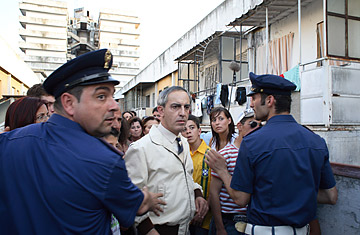
A scene from Gomorrah
Simone and Roberto have been friends forever, but now they belong to opposing factions in the Camorra Mob. "I'm telling you," one warns the other, "if you don't change sides, we might kill you. Or you might kill us. Because we're at war. People are dying every day." The mortal rivals give each other a final farewell kiss on the cheek; they're boys of about 12.
Matteo Garrone's Gomorrah, called Gomorra in Italy and based on the best-selling exposé by Roberto Saviano, is probably the bleakest, least sentimental study of the Mafia in Italian or American film history. In its depiction of the Camorra crime family, there are no good guys, no crusading cops, no mama pleading with her son to stay out of the rackets. There's also no Mr. Big, Dr. No or Don Corleone stroking a house cat and intoning gritty or pearly aphorisms. The movie stays at street level, showing the lower- and middle-rung employees enmeshed in a system they can't escape, the perps or victims of murders dispatched with neither mercy nor regret. (See pictures of the most notorious Mafia leaders of the past two decades.)
The panorama of malefactors includes a 13-year-old boy who is shot point-blank while wearing a bulletproof vest during an initiation rite that is like a Mafia bar mitzvah ("Now you are a man"); a middle-management toughie who, like Tony Soprano, is in the waste-disposal business (the Camorra holds a monopoly in this industry); and two punks who quote the Pacino Scarface and think they've hit the jackpot when they stumble on a weapons stash. ("Let's rack up corpses," one says. "No use feeling depressed.") Above these scarred, drugged-out creatures are their bosses, wealthy mobsters who are still middle management in the giant organization. And to the side, but never out of firing range, nonviolent types like the master tailor who, to make some extra money, agrees to tutor seamstresses at a Chinese garment factory across town. That too is punishable by death.
Less a traditional crime film than an as-told-to social document, Gomorrah reveals the reach of a business that has poisoned an entire region; for Camorra is both a crime syndicate and one of the nation's largest employers — southern Italy's own stimulus package. Where else in a sluggish economy can a young man find work? (In the movie, a college graduate, lured into a job supervising the dumping of toxic waste, decides to quit the business. His padrone, disgusted, spells out what awaits him: "Go make pizzas.") When everyone in town is either a gangster or his potential victim, kids learn early to choose sides. What's exciting and, briefly, enriching for the boys, the Mob sees as labor that's cheap, malleable, expendable. In this sense, the film is Slumdog Millionaire without the girl, the songs or even a long shot at redemption.
The style of Garrone's film — long, episodic, solidly acted by a mix of familiar screen faces and nonprofessionals — is no more than efficient. But because violence erupts without warning, Gomorrah keeps you alert through the mundane parts. In the first scene, meaty men get gunned down in a tanning salon. That sets the movie's dramatic coordinates. People die stepping outside their front door, or in a whorehouse, or just fooling around on the street. In a typical crime movie, there's a suspenseful buildup to the bog kills. Here, death explodes prosaically, capriciously, as in Baghdad or Kabul.
What sticks in the mind is the numbing information imparted at the end of the movie: that the Camorra empire earned 150 billion euros in 2007; that in addition to dealing in drugs and arms, it invests in legitimate businesses around the world, including the reconstruction of the World Trade Center; that in the past three decades, the Camorra has murdered more people than al-Qaeda has. It is these statistics, rather than the movie's viral vignettes, that hold the real power and horror of Gomorrah.
